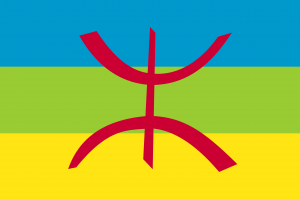Language/Central-atlas-tamazight/Grammar/Pronouns
Hi Central Atlas Tamazight learners! 😊
In this lesson, we will be discussing pronouns in Central Atlas Tamazight. Pronouns are an essential part of speech, and mastering them will help you communicate more effectively in Central Atlas Tamazight. Let's get started!
Take some time to dive into these other pages after completing this lesson: Adjectives, Plurals & Questions.
What are Pronouns?[edit | edit source]
Pronouns are words that are used to replace nouns. They are used to avoid repetition in a sentence and make communication more efficient. For example, instead of saying "Ahmed went to Ahmed's house to get Ahmed's books," you can say "Ahmed went to his house to get his books."
In Central Atlas Tamazight, pronouns are inflected, meaning they change form to show different grammatical categories like person, number, and gender.
Personal Pronouns[edit | edit source]
Personal pronouns are used to refer to people or things. In Central Atlas Tamazight, personal pronouns have different forms depending on the grammatical person, number, and gender. Below is a table that shows the personal pronouns in Central Atlas Tamazight:
| Person | Singular | Plural | |||||||||
|---|---|---|---|---|---|---|---|---|---|---|---|
| aya | nya | tayri | seri | aka | nka | tina | sina | u | yu | t | yt |
Here are some examples of personal pronouns in use:
- Ahmed: azul aya? (Hi, how are you?)
- Fatima: afouss tina, afouss tayri? (Good, and you?)
- Ahmed: afouss nka. (Good, for you.)
Notice that the forms aya and nya are used when addressing a male, tayri and seri when addressing a female, aka and nka when addressing a male, and tina and sina when addressing a female.
Possessive Pronouns[edit | edit source]
Possessive pronouns are used to show ownership or possession. In Central Atlas Tamazight, the possessive pronoun changes depending on the gender and number of the noun.
Below is a table of the possessive pronouns in Central Atlas Tamazight:
| Gender/Number | Pronoun | ||
|---|---|---|---|
| nn | nn | nn-un | nn-unt |
Here are some examples of possessive pronouns in use:
- Ahmed: nn gis askar. (This is my soldier's jacket.)
- Fatima: nn-unt afenna akw. (These are our houses.)
- Ahmed: nn-uwla mazal. (His shoe is still there.)
- Fatima: nn-ann tahita. (Her boat.)
Reflexive Pronouns[edit | edit source]
Reflexive pronouns are used to reflect back to the subject of the sentence. In Central Atlas Tamazight, reflexive pronouns are formed by adding the prefix "as" to the personal pronoun. Below is a table of reflexive pronouns in Central Atlas Tamazight:
| Person | Pronoun | Reflexive Pronoun | |||||||||||||
|---|---|---|---|---|---|---|---|---|---|---|---|---|---|---|---|
| aya | as-aya | nya | as-nya | aka | as-aka | nka | as-nka | u | as-u | t | as-t | yun | as-yun | yunt | as-yunt |
Here are some examples of reflexive pronouns in use:
- Ahmed: azagzaw as-aya gma a tayri. (I look at myself in the mirror.)
- Fatima: as-nka tbaqsa tinin. (You hurt yourself with the knife.)
- Ahmad: as-u ksayfa kra-unin. (He is shaving himself.)
Demonstrative Pronouns[edit | edit source]
Demonstrative pronouns are used to point out specific people, places or things. In Central Atlas Tamazight, demonstrative pronouns can be used to indicate either "this" or "that." There are three forms of demonstrative pronouns in Central Atlas Tamazight:
| Gender | Singular | Plural |
|---|---|---|
| hddad | hdden | hddal | hddalt |
Here are some examples of demonstrative pronouns in use:
- Ahmed: hddad ayssijin id kano. (This book is mine.)
- Fatima: hdden ayawdi tayri. (Those pictures are yours.)
- Ahmed: hddalt acku ur-itettman-as d amar. (That is what he wants to do.)
Dialogue[edit | edit source]
Here is a dialogue that features many of the pronouns we learned in this lesson:
- Ahmed: azul aya? (Hi, how are you?)
- Fatima: afouss tina, afouss tayri? (Good, and you?)
- Ahmed: afouss nka. amekka tawqqurt n udayda? (Good, do you like the city of Udayda?)
- Fatima: ih, tawqqurt-iyi d tawqqurt-ann-ik. Ayfu yund-iyi aya, tura yund-ann-nka-s. (Yes, my city and your city. My family is there, and yours is here.)
- Ahmed: aya, nn gis askar izd akayad nn-uwla. Azzul-iw yurzen-a as-aya, tura azzul-t-aw yurzen-t-as nka. (Yes, this is my soldier's jacket and this is my shoe. I will take mine with me and you can take yours with you.)
Remember, if you have any questions about pronouns or any other aspect of Central Atlas Tamazight, you can find more information on Polyglot Club, or ask questions to native speakers!

